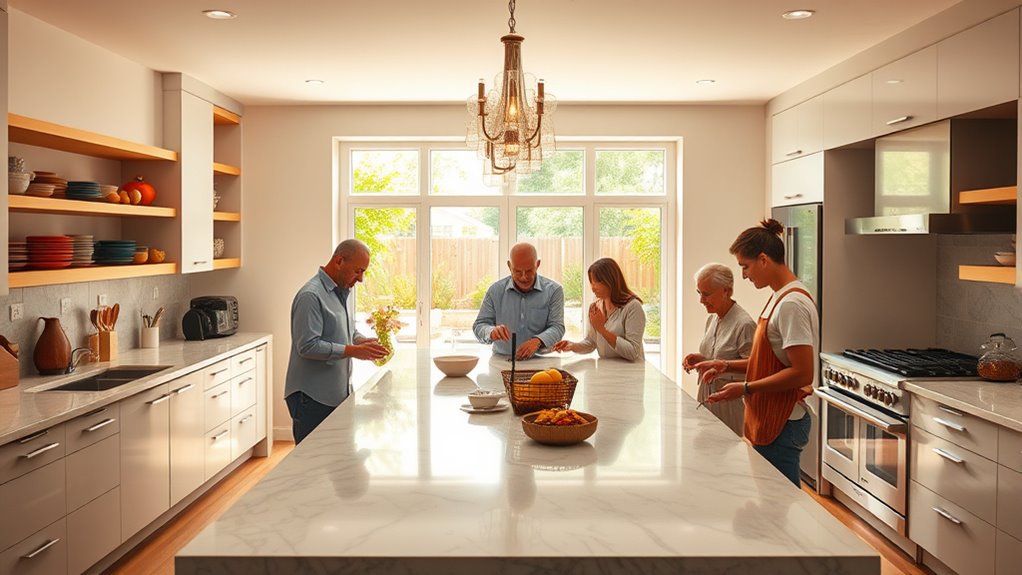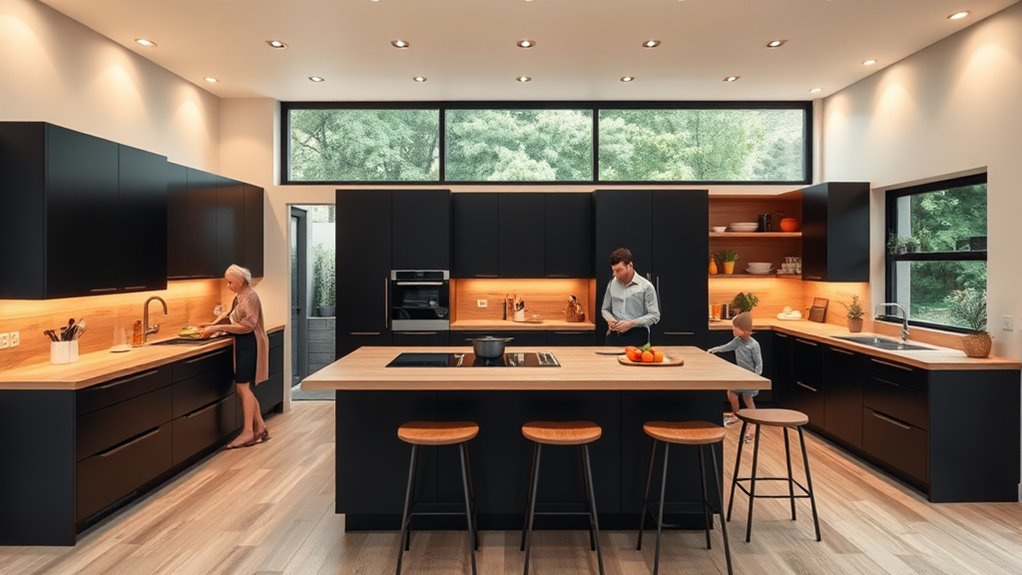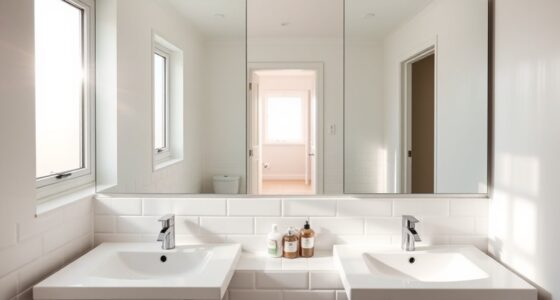When designing a kitchen for multiple generations, create distinct zones that balance privacy and connection. Incorporate features like separate seating, partial barriers, and well-placed appliances for easy access. Use clutter-free layouts and smart storage to boost efficiency, while choosing calming colors and ergonomic designs for comfort. Smart technology and thoughtful zoning help everyone feel at ease. To discover how to make your space work best, keep exploring the best strategies for multigenerational kitchens.
Key Takeaways
- Incorporate designated zones and partial barriers to balance privacy with shared activity in the kitchen.
- Use integrated appliances and strategic placement to optimize flow and reduce clutter for multiple users.
- Maximize storage with vertical solutions to keep countertops clear and facilitate efficient meal prep.
- Design ergonomic, accessible layouts with calming colors to ensure comfort and safety for all ages.
- Implement smart technology and thoughtful zoning to enhance convenience, privacy, and harmonious multi-generational use.

Are you planning a kitchen that can comfortably serve multiple generations? If so, you need to think carefully about how the space will function for everyone involved. Multigenerational living often means balancing different needs, preferences, and routines, so designing a kitchen that accommodates all ages can be tricky but rewarding. One key aspect to contemplate is privacy concerns. With several family members sharing the space, privacy becomes a priority—especially when it comes to personal space and quiet moments. You might want to incorporate zones within the kitchen, such as separate seating areas or nooks, that allow individuals to have a bit of solitude while still being part of the shared environment. Installing partial barriers or using furniture arrangement to create visual separation can help address privacy concerns without making the space feel isolated.
Designing a multigenerational kitchen requires zones for privacy and shared space harmony.
Equally important is appliance integration. When multiple generations share a kitchen, it’s essential to optimize layout and technology to make cooking and cleaning as seamless as possible. Modern appliances that can be integrated into cabinetry not only streamline the look but also reduce clutter, making the space safer and more accessible. For example, built-in ovens, slide-in ranges, and hidden microwaves can be tucked away to keep counters clear, which benefits both safety and efficiency. Consider appliances with user-friendly interfaces, especially for older family members who may have different comfort levels with technology. Smart appliances with voice activation or remote control features can further simplify tasks and enhance convenience.
As you design, think about how appliance placement affects flow and accessibility. Position frequently used items within easy reach to avoid unnecessary bending or stretching. For instance, placing the refrigerator near the prep area or sink minimizes walking distance and saves time. Also, incorporate ample storage to keep countertops clutter-free, which is essential when multiple cooks are involved. When planning for appliance integration, don’t overlook the importance of good ventilation and noise reduction features. Quiet, well-ventilated appliances help keep the environment comfortable for everyone, especially if some family members are sensitive to noise or if the kitchen is open to other living spaces. Additionally, utilizing vertical storage solutions can maximize space and improve organization, making the kitchen more functional for all users. A thoughtful approach to kitchen layout can greatly enhance overall efficiency and comfort.
Incorporating mindfulness principles such as calming colors and organized layouts can also promote a peaceful atmosphere, even during busy meal preparations. It’s also beneficial to consider ergonomics to reduce strain and fatigue for users of all ages. Ultimately, creating a multigenerational kitchen involves balancing privacy concerns with practical appliance integration. The goal is to foster a space where everyone feels comfortable, safe, and efficient. Thoughtful zoning, smart technology, and strategic placement can make a big difference, ensuring the kitchen becomes a hub of activity that truly serves the needs of your entire family.
Frequently Asked Questions
How Can I Ensure Privacy in a Shared Kitchen Space?
To guarantee privacy in a shared kitchen, you should create designated privacy zones where individuals can retreat. Installing soundproof barriers or panels helps minimize noise transfer, giving everyone a sense of personal space. Use curtains or sliding doors to separate cooking areas when needed. Clear signage or visual cues can also remind everyone to respect each other’s privacy, making the shared space more comfortable for all.
What Safety Features Are Recommended for Elderly Family Members?
Did you know falls are a leading cause of injury among seniors? To keep elderly family members safe, install ergonomic tools that reduce strain and improve control. Guarantee emergency exits are clearly marked and easily accessible. Add non-slip mats, grab bars, and proper lighting. Regularly check appliances and pathways for hazards. These safety features create a secure environment where your loved ones can cook confidently and independently.
How to Balance Style and Functionality in a Multigenerational Kitchen?
To balance style and functionality in your multigenerational kitchen, focus on smart appliance placement to keep everything within easy reach, ensuring safety and efficiency. Use storage optimization techniques like shallow cabinets or pull-out shelves to reduce clutter while maintaining a sleek look. Choose durable, attractive materials that blend aesthetics with practicality. This way, your kitchen stays beautiful and functional for everyone, regardless of age or needs.
Are There Specific Appliances Suited for Different Age Groups?
You’ll find that choosing appliances tailored to different age groups makes cooking easier for everyone. Look for appliance customization options and age-specific gadgets, like user-friendly microwaves with simple controls for seniors, or multifunctional devices that suit busy families. By selecting versatile, accessible appliances, you guarantee your kitchen supports all generations comfortably and efficiently, creating a space where everyone feels confident and cared for while cooking or cleaning.
How Can I Incorporate Cultural Preferences Into Kitchen Design?
You can incorporate cultural preferences into your kitchen design by selecting elements that reflect your cultural aesthetics and traditional cooking practices. Choose vibrant colors, patterns, and materials that honor your heritage. Incorporate traditional cooking tools and appliances, and design a layout that accommodates communal cooking. Personal touches like cultural artwork or custom cabinetry also enhance the space, making it a warm, inviting environment that celebrates your cultural identity.
Conclusion
Designing a kitchen for multigenerational living means balancing tradition with modern needs, all while keeping everyone comfortable. Think of it as your personal Batcave—adaptable, functional, and welcoming. By incorporating flexible layouts and thoughtful features, you create a space where generations can thrive together, much like the timeless teamwork of the Avengers. With a little planning, your kitchen becomes more than just a room; it’s the heart of your home—ready for whatever the future holds.









